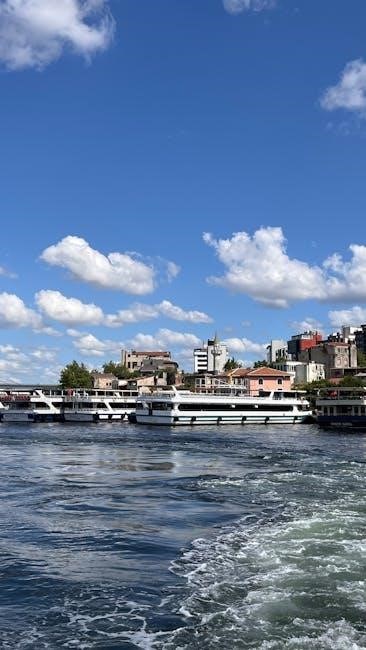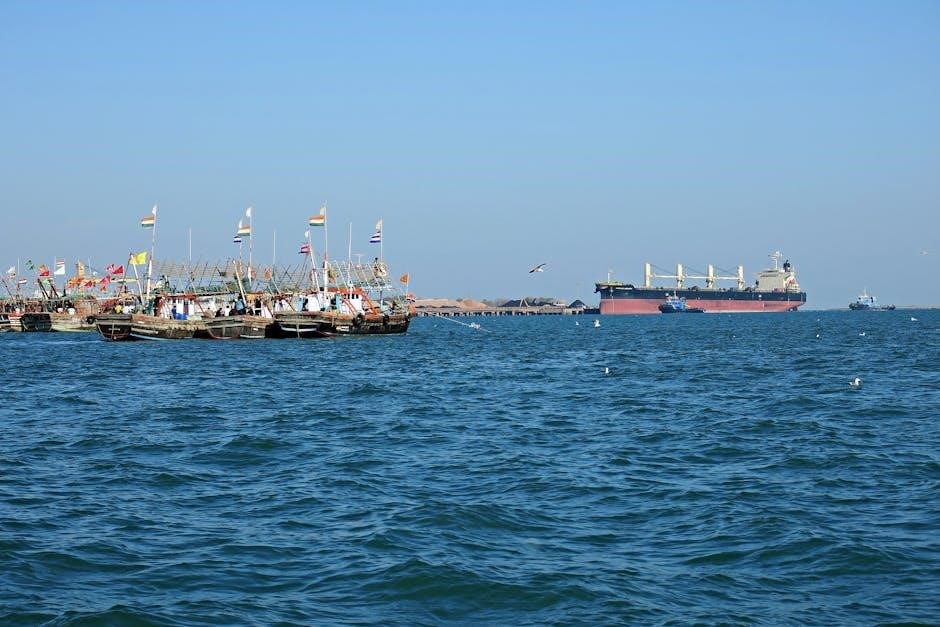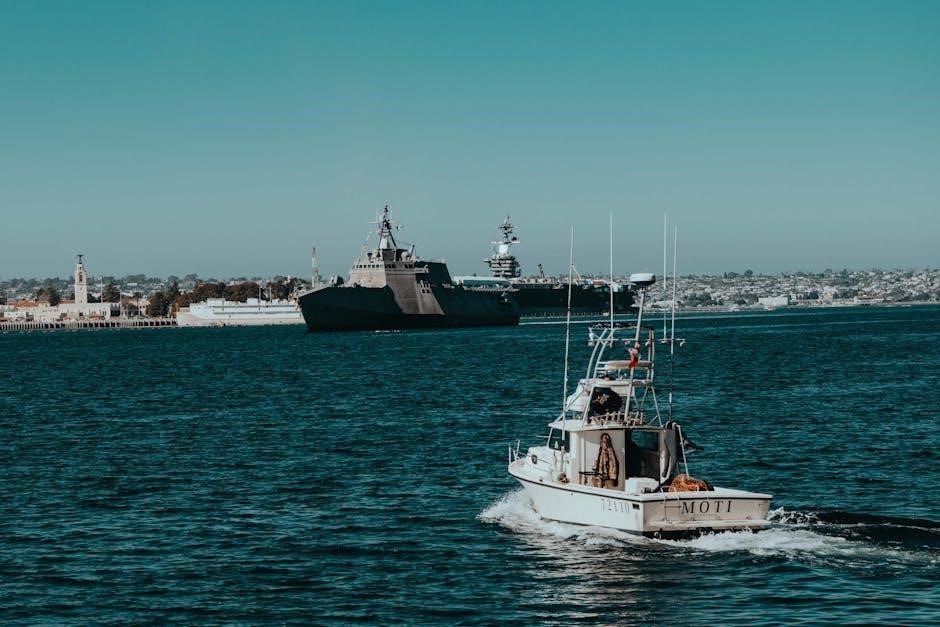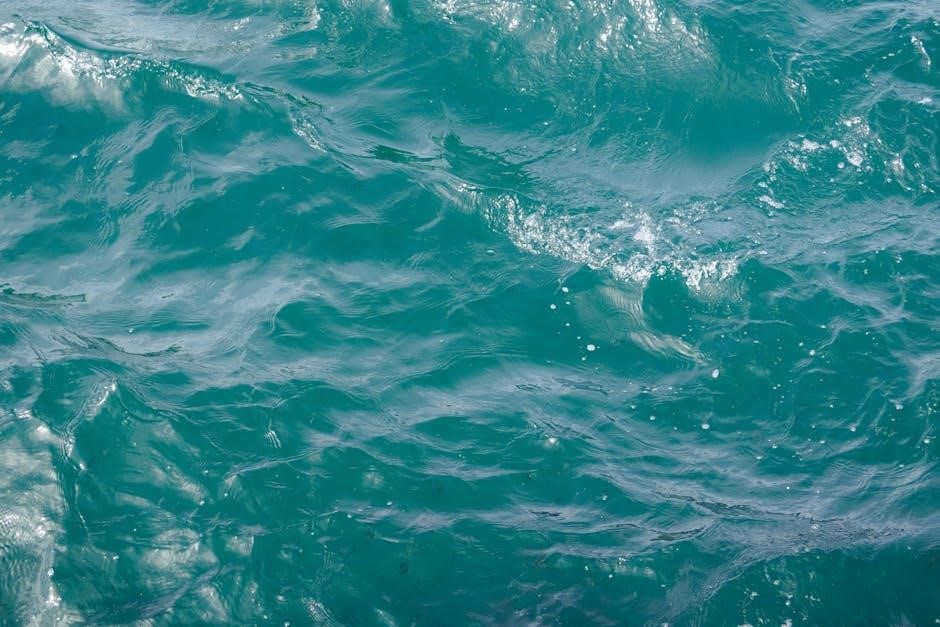Rosemount Guided Wave Radar is Emerson’s advanced solution for accurate level measurement using microwave technology, ensuring reliability and efficiency in various industrial applications.
Overview of Guided Wave Radar Technology

Guided Wave Radar (GWR) technology measures level and interface levels using microwave pulses. It operates by transmitting waves via a probe, which reflect off the medium’s surface. The time difference between transmitted and reflected waves determines the level. GWR is highly accurate, reliable, and unaffected by process conditions like density or pressure. It excels in challenging environments, handling liquids, slurries, and solids with minimal maintenance due to no moving parts. This technology is widely adopted for its versatility and precision in industrial applications.
History and Development of Rosemount Guided Wave Radar
Rosemount Guided Wave Radar (GWR) technology has evolved significantly since its introduction. Emerson, a leader in measurement solutions, developed Rosemount GWR to address challenging level measurement needs. The technology emerged in the 1990s as an alternative to traditional methods, offering superior reliability. Over the years, advancements in microwave signal processing and probe design have enhanced its performance. Emerson’s commitment to innovation led to the creation of the Rosemount 3300 and 5300 series, which became industry standards for accuracy and durability in demanding environments.

How Guided Wave Radar Works
Guided Wave Radar uses microwave pulses guided down a probe, reflecting off the material’s surface to measure level based on time-of-flight principles.
Microwave Technology in Level Measurement
Microwave technology in Rosemount Guided Wave Radar emits high-frequency waves that travel down a probe, reflecting off the material’s surface. The time-of-flight of these waves is measured to determine the level. This method ensures accurate measurements across various process conditions, including high pressure, temperature fluctuations, and dense vapors. Unlike other technologies, microwaves are unaffected by dust, noise, or viscosity, making them highly reliable for level and interface measurements in liquids, slurries, and solids.
Principle of Guided Wave Radar Operation
Rosemount Guided Wave Radar operates by emitting microwave pulses down a probe, which reflect off the material’s surface and return to the transmitter. The time-of-flight of these pulses is calculated to determine the level. The probe guides the microwaves, ensuring direct contact with the material, and the technology is unaffected by dust, noise, or viscosity. This method provides accurate and reliable measurements for liquids, slurries, and solids in challenging process conditions.
Advantages of Rosemount Guided Wave Radar
Rosemount Guided Wave Radar offers high accuracy, reliability, and minimal maintenance with no moving parts. It excels in challenging conditions, providing versatile level measurement for liquids, slurries, and solids.
High Accuracy and Reliability
Rosemount Guided Wave Radar ensures precise and dependable level measurements, unaffected by changing process conditions. Its advanced microwave technology provides consistent accuracy, even in challenging environments. With no moving parts, the system minimizes wear and tear, delivering long-term reliability. This makes it ideal for industries requiring consistent performance, such as oil and gas, chemical processing, and power generation. Its robust design ensures accurate readings, maintaining operational efficiency and reducing potential downtime.
Minimal Maintenance and No Moving Parts
The Rosemount Guided Wave Radar features a robust design with no moving components, eliminating the need for frequent maintenance. This reduces operational downtime and extends the product’s lifespan. The absence of moving parts also minimizes wear and tear, ensuring consistent performance in harsh environments. Additionally, the radar’s self-diagnostic capabilities further enhance reliability, making it a low-maintenance solution for various industrial applications. This design ensures uninterrupted and accurate level measurements, contributing to overall process efficiency and safety.
Handling Challenging Process Conditions
Rosemount Guided Wave Radar excels in handling demanding process conditions, including high pressure, extreme temperatures, and varying dielectric constants. Its robust design ensures accurate measurements even in harsh environments with dense vapors, dust, or agitation. The technology is unaffected by changes in density, viscosity, or conductivity, making it reliable for diverse industrial applications. Advanced algorithms further enhance its ability to adapt to complex process dynamics, ensuring precise and consistent level measurements regardless of operational challenges.
Applications of Rosemount Guided Wave Radar
Rosemount Guided Wave Radar is widely used for level measurement in liquids, slurries, and solids, as well as interface detection across various industries, ensuring versatility and precision.

Level Measurement in Liquids, Slurries, and Solids
Rosemount Guided Wave Radar excels in measuring levels of liquids, slurries, and solids. Its microwave technology ensures accurate and reliable readings, unaffected by process conditions. The radar’s ability to handle challenging environments, such as high pressure and temperature, makes it ideal for industries like oil and gas, chemical processing, and power generation. With no moving parts, it minimizes maintenance and provides consistent performance in demanding applications, ensuring precise level measurement across diverse materials and conditions.
Interface Measurement Capabilities
Rosemount Guided Wave Radar offers exceptional interface measurement capabilities, accurately detecting the boundary between two materials. Its microwave technology ensures reliable performance, unaffected by process conditions like density or pressure. The radar’s ability to measure both level and interface makes it ideal for applications involving liquids, slurries, and solids. This capability is particularly valuable in industries requiring precise separation monitoring, such as oil-water interfaces in petroleum processing or liquid-liquid interfaces in chemical plants, ensuring operational efficiency and safety.
Industry-Specific Applications
Rosemount Guided Wave Radar is widely applied across various industries due to its reliability and accuracy in challenging environments. In oil and gas, it excels in measuring liquids and interfaces, such as oil-water separation. Chemical processing benefits from its ability to handle corrosive materials. Power generation and water treatment utilize it for level measurements in boilers and wastewater. Additionally, it is employed in the food and beverage industry for hygienic level monitoring. Its versatility ensures precise measurements in demanding conditions, making it a preferred choice across sectors.

Emerson’s Role in Guided Wave Radar Innovation
Emerson leads in guided wave radar innovation, advancing measurement solutions with cutting-edge technologies like the Rosemount 3051 and 5300 series, ensuring optimal performance and reliability across industries.
Emerson’s Commitment to Advanced Measurement Solutions
Emerson has over 50 years of expertise in delivering reliable measurement solutions. Their Rosemount portfolio, including the 5300 and 3051 series, exemplifies innovation, offering high accuracy and durability in demanding environments. Emerson’s commitment to advanced technologies ensures minimal maintenance and optimal performance, making their systems ideal for industries requiring precise level and pressure measurements. Their focus on continuous improvement drives the development of cutting-edge solutions, solidifying their leadership in industrial measurement.
Evolution of Rosemount Guided Wave Radar Products
The Rosemount Guided Wave Radar has evolved significantly, starting with the 3300 Series, known for its accuracy and reliability in level measurements. Emerson expanded its portfolio with the 5300 Series, offering enhanced performance for challenging applications. Continuous innovation has led to improved reliability, minimal maintenance, and advanced safety features. These advancements ensure the Rosemount Guided Wave Radar remains a leader in level measurement technology, adapting to industry needs and delivering precise results across various environments.

Key Features of Rosemount Guided Wave Radar
Rosemount Guided Wave Radar offers advanced microwave technology, high accuracy, and reliability in demanding environments. It features no moving parts, minimal maintenance, and seamless integration with control systems.
Superior Performance in Demanding Environments
Rosemount Guided Wave Radar excels in challenging conditions, delivering precise measurements regardless of pressure, temperature, or medium. Its robust design withstands harsh environments, ensuring reliability in extreme industrial applications. With no moving parts, it minimizes maintenance and offers consistent accuracy. The technology is unaffected by dust, noise, or varying dielectric constants, making it ideal for liquids, solids, and slurries. Its durability and adaptability ensure superior performance in demanding settings, enhancing operational efficiency and safety across industries.
Enhanced Safety and Reliability
Rosemount Guided Wave Radar ensures enhanced safety and reliability in industrial applications. It is certified to IEC 61508 for SIL2 applications, meeting stringent safety standards. The absence of moving parts reduces mechanical failure risks, while its robust design handles extreme conditions. Advanced diagnostics and self-checking capabilities provide real-time monitoring, ensuring accurate and dependable performance. This technology is engineered to maximize operational safety, minimize downtime, and deliver consistent results in demanding environments, making it a trusted solution for critical level measurement needs.

Integration with Modern Control Systems
Rosemount Guided Wave Radar seamlessly integrates with modern control systems, ensuring efficient data communication and process monitoring. Compatible with various protocols like HART and Modbus, it enables real-time data transmission for precise control. Its advanced connectivity options enhance system scalability and flexibility, allowing for easy incorporation into existing automation frameworks. This integration capability ensures smooth operation, improved decision-making, and enhanced productivity in industrial environments, making it a versatile solution for advanced process control needs.
Comparison with Other Level Measurement Technologies
Rosemount Guided Wave Radar offers superior accuracy and reliability compared to traditional methods, minimizing maintenance and excelling in challenging process conditions with advanced microwave technology.
Guided Wave Radar vs. Traditional Level Measurement Methods
Guided Wave Radar (GWR) surpasses traditional methods like ultrasonic or pressure-based systems by offering higher accuracy and reliability. Unlike older technologies, GWR is unaffected by dust, noise, or varying process conditions. It requires minimal maintenance due to no moving parts and provides consistent performance across liquids, slurries, and solids. Traditional methods often struggle with accuracy in challenging environments, while GWR excels in demanding applications, making it a preferred choice for modern industrial level measurement needs.
Advantages Over Ultrasonic and Radar Technologies
Rosemount Guided Wave Radar offers superior performance compared to ultrasonic and traditional radar technologies. It eliminates issues like signal interference and echo interpretation, providing precise measurements regardless of dust, noise, or temperature fluctuations. Unlike ultrasonic devices, GWR operates reliably in high-pressure and high-temperature environments. Additionally, it requires no recalibration and has no moving parts, reducing maintenance and downtime. This makes it a more robust and dependable choice for challenging industrial level measurement applications compared to other radar and ultrasonic systems.
Future Trends in Guided Wave Radar Technology
Future trends include integrating Rosemount GWR with IIoT, enhancing accuracy, and expanding applications across industries, ensuring Rosemount remains a leader in level measurement innovation.
Emerging Innovations in Level Measurement
Emerging innovations in level measurement include advanced software algorithms, improved sensor designs, and integration with IIoT platforms. Rosemount Guided Wave Radar is evolving to offer enhanced accuracy, real-time data analysis, and predictive maintenance capabilities. These advancements enable better process control, reduced downtime, and improved safety in industrial applications. Innovations also focus on adapting GWR technology for challenging environments, ensuring reliability in extreme temperatures, high pressures, and corrosive materials. Such developments solidify Rosemount’s position as a leader in level measurement solutions.
Expanding Applications Across Industries
Rosemount Guided Wave Radar is increasingly being adopted across various industries, including oil and gas, chemical processing, food and beverage, and power generation. Its versatility in measuring liquids, slurries, and solids makes it ideal for diverse applications. From tank level monitoring in refineries to interface measurement in petrochemical plants, GWR technology ensures accurate and reliable performance. Its ability to handle challenging conditions has expanded its use in wastewater treatment, mining, and pharmaceutical industries, solidifying its role as a versatile and indispensable measurement solution.

Maintenance and Troubleshooting Tips
Rosemount Guided Wave Radar requires minimal maintenance due to its no-moving-parts design, reducing downtime and calibration needs. Regular cleaning of the probe ensures optimal performance in demanding environments.

Best Practices for Optimal Performance
To ensure optimal performance, install Rosemount Guided Wave Radar in a location free from interference and follow proper configuration guidelines. Regularly inspect and clean the probe to avoid material buildup. Verify the radar’s compatibility with the process medium and operating conditions. Perform periodic firmware updates and calibration checks as recommended. Ensure proper grounding and shielding to minimize electromagnetic interference. Follow Emerson’s maintenance schedules and troubleshooting guides for extended reliability and accuracy in level measurement applications.
Common Issues and Solutions
Common issues with Rosemount Guided Wave Radar include signal interference from nearby electromagnetic sources, which can be resolved by ensuring proper grounding and shielding. Probe fouling due to material buildup should be addressed through regular cleaning and inspection. Calibration discrepancies can occur if the device is not properly configured for the specific process medium, requiring adherence to Emerson’s setup guidelines. Addressing these issues ensures reliable and accurate level measurements in demanding industrial environments.
Rosemount Guided Wave Radar offers reliable, accurate level measurement solutions, excelling in challenging environments with minimal maintenance, making it a top choice for industrial applications.
Rosemount Guided Wave Radar offers high accuracy, reliability, and minimal maintenance, making it ideal for challenging industrial environments. Its advanced microwave technology ensures precise level and interface measurements, unaffected by process conditions. With no moving parts, it reduces downtime and recalibration needs, while its durability ensures long-term performance. Additionally, it integrates seamlessly with modern control systems, providing real-time data for efficient process management. These features make it a versatile and dependable solution for various industries.
Final Thoughts on the Technology’s Impact
Rosemount Guided Wave Radar has revolutionized level measurement with its precision, reliability, and adaptability. By minimizing downtime and reducing maintenance, it enhances operational efficiency and safety across industries. Its ability to handle challenging conditions and integrate with modern systems underscores its versatility. As a leader in measurement innovation, Rosemount Guided Wave Radar continues to set new standards, driving advancements in industrial automation and ensuring optimal performance in demanding environments.
